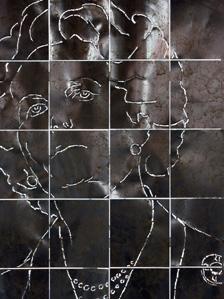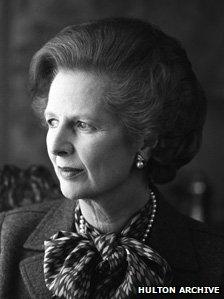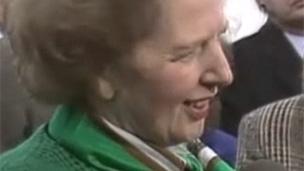Margaret Thatcher: An unlikely architect of Welsh devolution
- Published

A huge tin portrait of Margaret Thatcher hung in the Senedd in 2008
In 2008, a row broke out about the display of a portrait of Margaret Thatcher at the Senedd.
One Plaid Cymru AM called putting it there an "insult to the people of Wales".
In office, Thatcher had become hated in Wales in a way that no previous prime minister had. Two decades later she still invoked feelings stronger than any other political figure in Welsh history.
At the heart of this hatred lies her economic record. She came to power at a time of significant economic problems and rising unemployment was one of the key reasons for her victory in 1979.
Yet the economy deteriorated after her election, at least partly because she prioritised fighting inflation over unemployment.
In 1979, there were some 65,800 people unemployed in Wales. By 1990, the year Thatcher left office, there were 86,600. Those bare statistics disguise just how bad things had got in between.
In 1986, there had been more than 166,000 people in Wales on the dole. By then less than 40% of Welsh households were headed by someone in full-time employment.
Being "on the social" was no picnic and it was the most vulnerable in society who suffered the most from Thatcherism's targeted public spending cuts. The government sought to reduce the value of benefits by removing various supplements and not always raising payments in line with inflation.
Thus, at a time when average earnings were growing beyond inflation, unemployment benefit fell in real terms, widening the gap between those in and out of work.
For those in work the 1980s were a period of rising disposable incomes, but even those sharing some of the growth in affluence were uncomfortable with Mrs Thatcher. Her Home Counties mannerisms and image never went down well in industrial communities.
She seemed antagonistic to the whole concept of a welfare state, something which was held dear in Wales, not least because of the fact that two Welshmen had been central to its establishment.
She also seemed to dislike local government, and the brunt of spending cuts fell on councils who became infused with an atmosphere of gloom, retrenchment and redundancies.
Rising wages
Rather than talking down the cuts, and thus talking up her own image in places like industrial Wales, Thatcher seemed to revel in this reeling back of the state.

Margaret Thatcher 'seemed to revel in this reeling back of the state'
Yet the irony was that the state was not getting particularly smaller. The unemployment her inflation-fighting policies were exacerbating meant it could not cut down on spending across the board.
Indeed, Welsh Office spending on health and personal social services grew from £543m in 1979-80 to £1,502m in 1990-91. This was because of rising wages, higher staff numbers, new hospitals, health promotion programmes and far more people using the service. The NHS she was so often accused of undermining actually grew under her governance.
Thatcher's treatment of the miners did not help her image in Wales either. Whatever the rights and wrongs of the 1984-5 strike, the miners endured more than a year without pay, were vilified by parts of the London media and were the victim of some fairly unjust and even brutal tactics at the hands of the authorities.
Although, by 1981, the proportion of Welsh employees working in mining and quarrying was just 3.8%, the coal industry still had a symbolic place at the heart of ideas of the Welsh nation.
Its workers were not the idle and unreasonable men that formed the caricature of 1970s strikers. Instead, they, like the ancestors of many in Wales, endured difficult and dangerous conditions for little reward or gratitude.
This meant when the coal industry collapsed at frightening speed after the strike the antipathy towards Thatcher increased.
There was plenty of coal left but little political will to exploit it. The south Wales coalfield moved into an operating profit for the first time since 1958 but pit closures continued and substantial recent investments were written off in what seemed to be a vindictive retaliation by the government.
By 1990, there were just six pits left in south Wales and less than 3,000 miners. When Thatcher had come to power there had been 27,000.
Free market
Partly to compensate for the scale of economic upheaval in Wales, Thatcher's government enacted a number of changes that did much - indeed more than any previous administration - to buttress the fortunes and status of the Welsh language.
After Gwynfor Evans threatened to starve himself to death, the government agreed to create a Welsh-language television channel. It also increased the subsidies to Welsh-language services and gave the language a place on every schoolchild's timetable.
The powers of the Welsh Office were extended and a host of new quangos were set up to monitor and govern Thatcher's free market state.
With quangos being appointed rather than elected and control of the Welsh Office being decided by how England voted, none of this was very democratic. But it did help modern Wales become a more defined nation than ever before and administrative devolution reached such proportions that it was not misleading to talk of the emergence of a Welsh state.
This did not help Thatcher's reputation in Wales because she played little direct part in it. Instead, the developments owed much to ministers within the Welsh Office pushing hard against the instincts of the government's leading lights.
An argument with Welsh Office minister Wyn Roberts revealed some of Thatcher's attitudes. Wales and Scotland, she thought, were holding England back. "You contribute nothing," she told Roberts before adding that the "only Conservatives in Wales are the English who moved in".
That was not true. For all the hatred that was often aimed at Thatcher, some of her policies were very popular. Few complained about the 140 new miles of Welsh motorway and trunk roads that were built between 1979 and 1990 or the 22 bypasses that alleviated Welsh towns of their traffic misery.
Even many opponents of privatisation admitted that the level of service from utility companies often seemed to improve once ownership passed out of public hands. Most popular was the right-to-buy scheme that by the end of 1991 had enabled nearly 84,000 council houses in Wales to be sold to their occupiers.
Such policies helped win Thatcher support across Wales, including amongst members of the working class who had previously voted Labour.
After the 1979 election she told Welsh Conservatives: "We received a third of all Welsh votes. Indeed, we cut such a swathe through Wales that if you wished to do so - and why not, for it is a lovely country - you could walk from the south-east corner to the north-western most point and find yourself on Conservative territory all the way."

Even with high unemployment, nearly 30% of Welsh voters backed the Conservatives in the 1987 general election
The Tory share of the vote fell slightly after 1979 but even in 1987, a year after unemployment reached its post-war peak, the party still received nearly 30% of Welsh votes.
Thus the idea that all of Wales was against Thatcherism is clearly wrong and even some of those who were anti-Thatcher were still in favour of some of her policies, not least when it enabled them to own their own homes.
What people were most opposed to was the way Thatcher represented an individualistic society. This ran against many people's basic instincts, but it was a society people were buying into when they bought their own council homes.
Moreover, while there was considerable popular concern about the unemployed and the plight of the miners, the reality was that little was done by the majority to oppose what was happening.
Even if people did, quite understandably, put themselves rather than society first, the antipathy towards Thatcher was strong enough that some started questioning the whole political system.
They began to wonder why Wales had to endure a prime minister that only a minority of its people had voted for. Enough people were perplexed by this that the resounding No vote in the 1979 referendum on devolution was turned into a narrow Yes in 1997. That makes Thatcher one of the architects of devolution. Perhaps she deserves a portrait in the Senedd after all.
Dr Martin Johnes is head of history at Swansea University and the author of Wales since 1939 (2012).